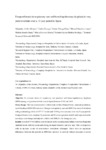Mostrar o rexistro simple do ítem
Temporal trends in respiratory care and bronchopulmonary dysplasia in very preterm infants over a 10-year period in Spain
| dc.contributor.author | Ávila-Álvarez, Alejandro | |
| dc.contributor.author | Zozaya, Carlos | |
| dc.contributor.author | Pértega-Díaz, Sonia | |
| dc.contributor.author | Sánchez-Luna, Manuel | |
| dc.contributor.author | Iriondo-Sanz, Martín | |
| dc.contributor.author | Elorza Fernández, Dolores | |
| dc.contributor.author | García-Muñoz Rodrigo, Fermín | |
| dc.date.accessioned | 2023-03-30T09:06:30Z | |
| dc.date.available | 2023-03-30T09:06:30Z | |
| dc.date.issued | 2022-03 | |
| dc.identifier.citation | Avila-Alvarez A, Zozaya C, Pértega-Diaz S, Sanchez-Luna M, Iriondo-Sanz M, Elorza MD, García-Muñoz Rodrigo F; Spanish Neonatal Network SEN1500. Temporal trends in respiratory care and bronchopulmonary dysplasia in very preterm infants over a 10-year period in Spain. Arch Dis Child Fetal Neonatal Ed. 2022 Mar;107(2):143-149. | es_ES |
| dc.identifier.issn | 1359-2998 | |
| dc.identifier.uri | http://hdl.handle.net/2183/32811 | |
| dc.description.abstract | [Abstract] Objective: To evaluate trends in respiratory care practices and bronchopulmonary dysplasia (BPD) among very preterm infants born in Spain between 2010 and 2019. Study design: This was a retrospective cohort study of data obtained from a national population-based database (SEN1500 network). Changes in respiratory care and BPD-free survival of infants with gestational age (GA) of 230-316 weeks and <1500 g were assessed over two 5-year periods. Temporal trends were examined by joinpoint and Poisson regression models and expressed as the annual per cent change and adjusted relative risk (RR) for the change per year. Results: A total of 17 952 infants were included. In the second period, infants were less frequently intubated in the delivery room and during neonatal intensive care unit stay. This corresponded with an increase in use of non-invasive ventilation techniques. There were no significant differences between the periods in BPD-free survival or survival without moderate-to-severe BPD. After adjusting for covariates, the RR for the change per year was significant for the following variables: never intubated (RR 1.03, 95% CI 1.02 to 1.04); intubation in the delivery room (RR 0.98, 95% CI 0.97 to 0.99); use of nasal intermittent positive pressure ventilation (RR 1.08, 95% CI 1.05 to 1.11); and BPD-free survival (only in the group with the lowest GA; RR 0.98, 95% CI 0.97 to 0.99). Conclusion: Our findings reveal significant changes in respiratory care practices between 2009 and 2019. Despite an increase in use of non-invasive respiratory strategies, BPD-free survival did not improve and even worsened in the group with the lowest GA (230-256). | es_ES |
| dc.language.iso | eng | es_ES |
| dc.publisher | BMJ | es_ES |
| dc.relation.uri | http://dx.doi.org/10.1136/archdischild-2021-322402 | es_ES |
| dc.rights | This article has been accepted for publication in Archives of disease in childhood, Fetal and neonatal edition following peer review, and the Version of Record can be accessed online at BMJ Journals web page. | es_ES |
| dc.subject | Intensive care units | es_ES |
| dc.subject | Neonatal | es_ES |
| dc.subject | Neonatology | es_ES |
| dc.subject | Respiratory medicine | es_ES |
| dc.title | Temporal trends in respiratory care and bronchopulmonary dysplasia in very preterm infants over a 10-year period in Spain | es_ES |
| dc.type | info:eu-repo/semantics/article | es_ES |
| dc.rights.access | info:eu-repo/semantics/openAccess | es_ES |
| UDC.journalTitle | Archives of disease in childhood. Fetal and neonatal edition | es_ES |
| UDC.volume | 107 | es_ES |
| UDC.issue | 2 | es_ES |
| UDC.startPage | 143 | es_ES |
| UDC.endPage | 149 | es_ES |
Ficheiros no ítem
Este ítem aparece na(s) seguinte(s) colección(s)
-
GI-GIRS - Artigos [101]






